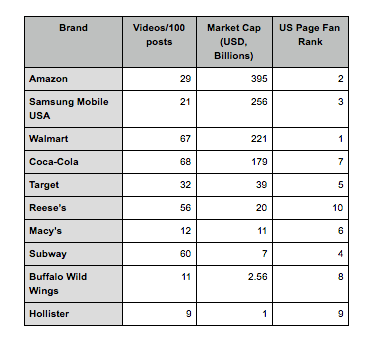
Get your FREE 30-day trial.
Please complete all fields.
The top 10 most successful brands on Facebook are overwhelmingly large enterprises, with market capitalization measured in billions. This cohort is the bellwether of Facebook marketing, and after an extensive analysis of their Facebook posting behavior, it’s clear that posting video has suddenly become a key part of their social media strategy. On average, 36.5% of their 100 most recent posts include video. If we break out the biggest companies, whose market capitalization is over $100 billion, 46.25% of their 100 most recent posts include video.

Source: Publicly available data on Facebook brand pages as of October 4th, 2016.
“We’re entering this new golden age of video,” Zuckerberg told BuzzFeed News. “I wouldn’t be surprised if you fast-forward five years and most of the content that people see on Facebook and are sharing on a day-to-day basis is video.” For the past few years, the world’s largest social network has been incredibly bullish on video -- but it’s been more than just grand plans, Facebook has followed through on their bullish expectations with stunning performance, overtaking YouTube as the world’s largest video sharing platform, for big brands in particular.
Source: Facebook
Much of the excitement of digital video is explained in charts and graphs describing how digital video ad spend is poised to reach $28 billion by 2020, up from just $10 billion in 2016, or that video ads have an average click-through rate (CTR) of 1.84%, the highest click-through rate of all digital ad formats. But there’s a more simple truth behind the rise of digital video advertising. Video captures attention better than any other ad format, then goes on to be the most compelling storytelling format. This simple truth is what fundamentally drives large enterprise adoption of digital video on Facebook and beyond.
But it’s not just large enterprises that benefit from digital video. Small and medium-sized businesses are poised to reap the benefits of digital video, perhaps even more than large enterprises. The phenomenal rise of digital video, on Facebook in particular, has led to unprecedented accessibility to a media format that was traditionally restricted to companies with big budgets. Production costs and high minimum ad spending requirements, even on local cable television networks, prevented most small businesses from using video effectively to grow their business. With the rise of self-serve digital video advertising, combined with the Instagrammification of media -- Instagram made beyond-amateur and even pro photography accessible to the masses, Wordpress Instagrammified blogging, Wix for websites, iPhones for video capture, and now Stupeflix, GoAnimate and Shakr for video post-production -- advertisers of all sizes can produce video ads to pursue growth.
Early evidence points to a shift towards smaller businesses standing to gain the most from video advertising on Facebook. Given the fine-grained targeting capability provided by Facebook and YouTube, and viewers’ natural tendency to gravitate towards authentic, local content, it’s no surprise that small and medium sized businesses achieve great results on limited budgets with digital video. Gizmo Angling, a UK-based local manufacturer of professional gear for the fishing industry, secured over 1,000 orders of their new hook-tying device within just 26 hours of posting their video online. Meanwhile, South Korea’s VC-backed international commerce app Snappy achieved a 450% decrease in Cost per Install and a 718% increase in clickthrough rate as a result of switching from photo ads to video ads. Today, about 70% of Snappy’s posts on Facebook are videos. And soon-to-go global lingerie brand The Zam attracted 3.9 million views with Facebook video, far outpacing their more provocative image advertisements, targeting female viewers and unlocking their most lucrative source of revenue growth.
Part of the performance of these SMBs video advertising campaigns can be attributed to Facebook users’ preferences to consume a wide variety of commercial content, evidenced by the rapid rise of ad fatigue. Facebook itself warns SMBs about ad fatigue, writing that they should “always refresh ad creative every 1 to 2 weeks for the best performance. When everyone in [a] target audience has already seen [an] ad many times, it becomes more expensive to achieve desirable results.” There are only two ways to effectively combat ad fatigue: show different content, or target new viewers. In local markets, this dilemma greatly favors the small business owners who target small audiences with fresh creative, while big businesses cast their nets far and wide with slow-moving content calendars.
These recent developments in video marketing are a tremendous shift towards the democratization, or Instagrammification, of the most compelling and effective advertising format. It should be no surprise, though. We’ve seen the democratization of media formats time and time again. Classified ads moved to Craigslist and beyond, text and image advertising shifted from newspapers and magazines to Google AdWords and Facebook. As it has been with all media formats, it remains with digital video: while large enterprises lead the way, SMBs reap the benefits. The increased availability and popularity of digital video advertising has already changed the media landscape, so much for the better.
David Lee is the founder and CEO of Shakr Media